Let’s face it, digging through scattered local news to find out what’s happening around you is never fun or easy. Although global platforms have been pumping out world news to keep us informed, local news sources are falling behind.
Starting out in San Francisco and now expanding across the US, Hoodline has been addressing this by bringing local and neighborhood news directly to users via API integrations in the apps and websites they already use, while boosting exposure for local businesses and working with local newsrooms.
With funding from top investors in technology and media, Hoodline offers two products to publishers: a local data newswire and a locally focused content recommendation module.
How does it work?
With its machine-learning platform Atlas, they’re able to tag and contextualize content from all over the internet (over 300 partners like ABC television, Groupon, Yelp, TripAdvisor and Vice) and sort it back to you via automated local content with additional filters and categories.
“Not only do we tag the correct neighborhood, sentiment, persona and category, but we also estimate the shelf life of a post down to the time when an event mentioned in the article is supposed to finish,” reveals Hoodline.
According to Hoodline, “This has allowed us to scale the process to automatically tag thousands of articles about thousands of locations coming from hundreds of publishers, distributing the right information to the relevant site or app.”
With over 200 partnering media publications, Hoodline localizes the articles with the following layers of metadata:
Location: down to the latitude and longitude of the exact place mentioned in the articleShelf life: one day, one month, or indefinitely
Topics: main categories, like Arts & Culture, Politics & Government to Crime & Safety, plus more than 50 subcategories
User persona: local, traveler and global
Sentiment: positive, neutral and negative
People: list of people mentioned in the article
Organizations: list of organizations mentioned in the article
“For the users, it’s really like having a personal location expert at the hit of a “nearby button” so you never miss out on some nearby action. Hoodline’s helping content become organized, accessible and packaged all in one place – perfect for when you’re travelling to a new city or just a local looking for something to do after work. We’re glad to be a part of the engine to power this,” says Filipe Teixeira Simões, STRV’s project manager.
You can even catch Hoodline’s news widget in Eventbrite’s weekly emails to its Bay Area users.
To make sure they’re sending relevant articles to the right places, Hoodline uses advanced machine learning to find the right set of locations inside the article itself, together with location-point density heuristics calculated on their proprietary GIS. Time and relevancy is also considered, as they put a shelf-life and expiration on time-sensitive articles that don’t need to stay in circulation for weeks or months.
“By testing and iterating on our location model, we’ve built an algorithm that today reaches 90 percent accuracy when predicting the exact focus city and it is also able extract all relevant exact locations mentioned by an article within a city. Our system also provides a complete feedback loop, where editors improve the tags, and machines learn from the new tags, and push the bar higher,” shares the Hoodline team.
The algorithms are programmed to determine sentiments (marking the overall article as either positive, negative or neutral), allowing you to choose what kind of content to see. This way, both the websites and partners themselves can benefit and cater a specific feed depending on their needs.
Mira Macik, STRV’s lead back-end developer for Hoodline shares “The biggest challenge (from the perspective of working on the API) is the amount of data we get. I spend a lot of time optimizing database queries and speeding up response times. Since we’ve got millions of posts and various filters, you can imagine it can sometimes get pretty challenging to keep up with a reasonable response time.”
To achieve good results, however, Mira adds that “We use both Redis cache and Postgres Materialized views. We also really focus a lot on the analytics – like ML quality control/successful rate. We use the latest tools like Coralogix, which is a machine learning powered log analytics solution.”
Hoodline’s core technologies
NodeJS, Postgres + Postgis, Heroku, Newrelic + Logentries + Rollbar, Amazon's Cloudfront + API Gateway + Lambda + S3. Some specialized services use Ruby, Scala/Java, Python.
You can currently catch Hoodline in action in 50 US cities, but it’s only a matter of time till we can expect national local-powered discovery at our fingertips.





